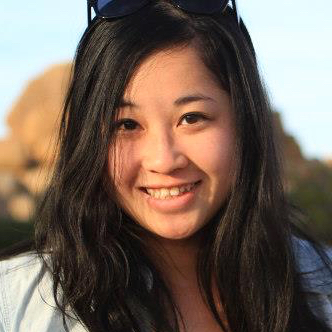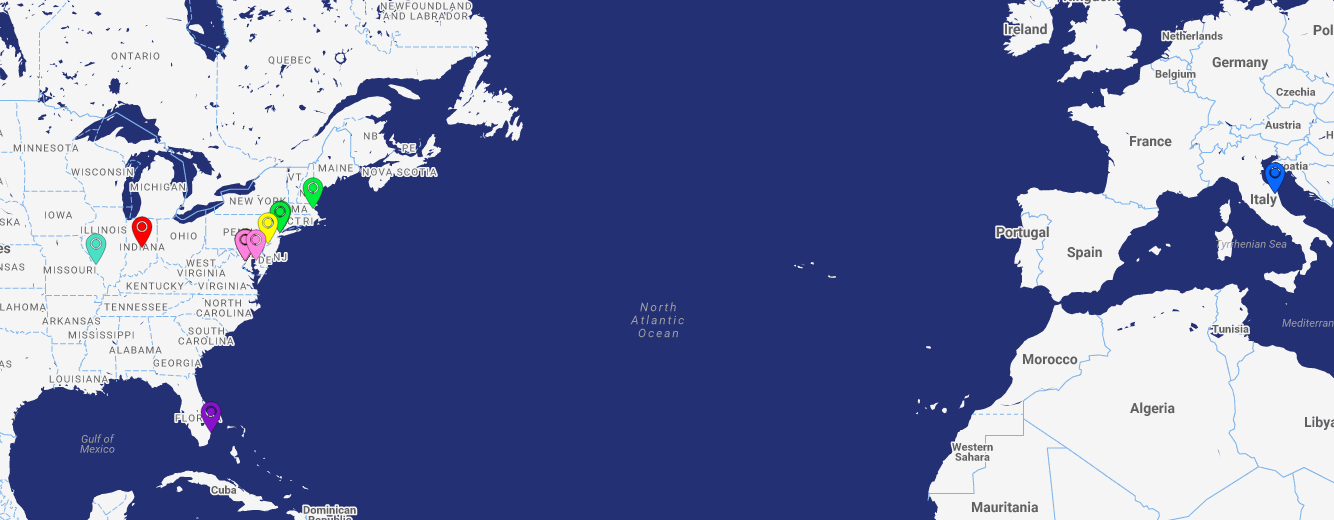SCOTUS Map: April and May 2017

on May 19, 2017 at 12:33 pm


Who doesn’t want to take a quick break in the middle of work and go to Italy?
On April 21, Justice Stephen Breyer took part in a conversation called “Judges as Diplomats in Advancing the Rule of Law,” organized by the Luxembourg Forum at American University. A brief recap comes from the American University School of Public Affairs News.
Justice Sonia Sotomayor spoke at the April 25 reception for the Legal Services Corporation’s Forum on Increasing Access to Justice. The following day, Justice Elena Kagan also praised LSC’s work in her remarks at the American Bar Association’s 2017 ABA Grassroots Advocacy Award ceremony. “You are doing the Lord’s work,” ABA News quotes Kagan as saying. “This is so important—the Legal Services Corporation—so many people depend on it, and depend on there being adequate funding for it.”
April 27, the day after the last of the term’s oral arguments, saw a flurry of activity from the justices, with at least four different appearances around Washington. Chief Justice John Roberts attended a Georgetown Law reception where Jeffrey Minear, the chief justice’s counselor, was honored. Roberts drew laughs for opening his speech with a reminder to the audience to “please turn off your cell phones” – a reference to Breyer’s phone unexpectedly ringing in the courtroom during the penultimate day of arguments. Mark Walsh has a summary of the festivities.
Justice Ruth Bader Ginsburg was also at Georgetown that day, speaking at the Marver H. Bernstein Symposium. Ginsburg’s talk touched on a wide range of topics, including the civility (or incivility) of Supreme Court confirmation hearings, unconscious bias against women, the living Constitution, and the strategic use of dissents. “I do not take every opportunity to dissent,” Ginsburg said, according to the Georgetown Hoya. “I do try to save them for when it counts, when it really matters. I keep on my desk the unpublished opinions of Justice Brandeis. His view was, his voice would be all the more compelling if he only dissented when it really mattered.” Additional coverage comes from The Hill. Video of the event is available online.
Meanwhile, Justice Samuel Alito was 10 minutes away at the Capital Hilton, headlining an American Bar Association Section of International Law luncheon. Alito described how dissents often have the effect of sharpening a justice’s writing: “If you write an opinion and you know you have to answer to a dissent, it makes you more careful” than when authoring a unanimous opinion. ABA News reports that Alito got in a jab at media coverage of the justices: “There is an awful lot of silliness that is written about the court.”
Speaking of media coverage, Sotomayor, who once spoke positively of her experience with cameras in the courtroom, said at the opening of a Library of Congress exhibition (“Drawing Justice: The Art of Courtroom Illustration”) that she is now hesitant about the idea of bringing cameras to the Supreme Court. The Washington Post covered the opening.
With the eight-member Supreme Court now a thing of the past, Kagan – who is no longer the junior justice and quite happy about that, Ginsburg surmised – took a walk down memory lane at the Seventh Circuit Bar Association Annual Meeting in Indianapolis on May 1. She stated that one result of working on a short-handed bench was that justices had to dig deeper and refine their reasoning, listening and persuasion skills in order to break 4-4 ties and reach consensus. According to The Indiana Lawyer, Kagan believes the Supreme Court did “pretty darn well” given the circumstances. She sees the court’s experience as applicable to politics in general:
I think the courts do model behavior. They teach people about reasoned decision-making and they teach people about collegiality. And when they’re working at their best, they also teach people about bridging differences and reaching agreement in places where you might not expect to find it.
Also on May 1, Ginsburg presided over a re-enactment of Goesaert v. Cleary at the Supreme Court. In that 1948 ruling, the Supreme Court held that a Michigan statute barring most women from being licensed as bartenders did not violate the 14th Amendment’s equal protection clause. Ginsburg noted after the argument that the opinion had affirmed “the prerogative of legislatures to draw a sharp line between the sexes,” and recalled that when she studied the case as a law student in the 1950s, neither the professor nor the casebook mentioned “the blatant gender-based discrimination infecting the Michigan law.” Andrew Hamm covered the event for this blog.
Sometimes a justice travels a long way to speak to an audience, and at other times the audience travels to the justice. On May 2, Justice Anthony Kennedy spoke to Sacramento business leaders and lawmakers who had come from Kennedy’s hometown in California to Washington as part of the Sacramento Metropolitan Chamber of Commerce’s “Capitol-to-Capitol” program. Attendees of the event, which was closed to the media, told Fox 40 that Kennedy’s speech touched on civility and the preservation of democracy, among other things.
Sotomayor spent some time overseas at the University of Macerata in Italy, participating in a May 3 conversation with students and a May 4 panel highlighting the experiences of female Supreme Court and constitutional court justices around the world.
Justice Clarence Thomas delivered the keynote speech at the Bar Association of Metropolitan St. Louis’ Law Day on May 5. According to the St. Louis Post-Dispatch, part of Thomas’ address focused on the irony that he sees in some young people and law students’ attitudes toward principles of limited government. “Some recoil or react as if something is being taken away. Yet in the very next breath they might express concern about the government’s overreaching under the Patriot Act, for example, or interference with their reproductive rights.” Thomas called this a “glib, simplistic” viewpoint: “They want the government to do what they want it to do, and refrain from doing what they don’t want it to do.”
Every spring, the New York City Bar Association hosts the Justice Ruth Bader Ginsburg Distinguished Lecture on Women and the Law, with Ginsburg providing the introductory remarks for that year’s speaker. On May 8, Ginsburg introduced Patricia Bell-Scott, author of a book about Eleanor Roosevelt and the legal scholar, activist and Episcopal priest Pauli Murray. Ginsburg credited Murray’s law review article “Jane Crow and the Law” with giving Ginsburg a “road map” for the equal citizenship stature arguments she made in 1971’s Reed v. Reed, which resulted in the Supreme Court’s application of the equal protection clause to sex discrimination. A transcript and a video of the justice’s speech are available via the New York City Bar Association.
On May 11, retired Justice John Paul Stevens made an appearance at the Galt Ocean Mile Reading Center in Fort Lauderdale, Florida, to discuss his two books, “Five Chiefs: A Supreme Court Memoir” and “Six Amendments: How and Why We Should Change the Constitution.”
Religious organizations played host to a couple of the justices in mid-May. Alito delivered the commencement speech at the Pontifical Faculty of the Immaculate Conception at the Dominican House of Studies in Washington on May 12, where he also received the Saint Dominic Medal. Five days later, Alito spoke at the Saint Charles Borromeo Seminary’s graduation ceremony in Philadelphia, where he warned the audience that Americans’ “strong respect for religious liberty” has “started to change.” According to Newsworks.org, Alito read from his 2015 dissent in Obergefell v. Hodges, saying: “I assume that those who cling to old beliefs will be able to whisper their thoughts in the recesses of their homes, but if they repeat those views in public they will risk being labeled as bigots and treated as such by governments, employers, and schools.”
Breyer promoted his book, “The Court and the World,” at a May 12 Sutton Place Synagogue event organized by the New York Board of Rabbis and the Interfaith Center of New York. The next day, he discussed the Constitution and Brown v. Board of Education at the St. Philip’s Episcopal Church’s 10th Annual Thurgood Marshall Law Day. Coverage of the latter event comes from the Episcopal News Service, which describes Breyer “clutching a biography of Marshall stuffed with leaves of paper scrawled with handwritten notes.” Of Brown’s legacy, Breyer said: “Of course it helped America by producing integration, but it helped America in other ways, too, that are just as important.” YouTube user Andy Jean has uploaded a video of Breyer’s talk (which begins at the 1:18:13 mark).
On May 18, Alito participated in a Q&A session at the Capitol Hill Chapter of the Federal Bar Association’s 2017 Supreme Court Luncheon.
Looking ahead to the rest of May:
- Breyer gives a talk at the Cambridge Public Library’s Democracy Day on May 20.
- Ginsburg receives the Burton Awards’ “Book of the Year in Law” Award for “My Own Words” on May 22.
- The following day, Ginsburg delivers remarks at the American Law Institute’s annual reception in Washington.
- Ginsburg participates in an Aspen Wye Fellows Discussion in Queenstown, Maryland, on May 24.


